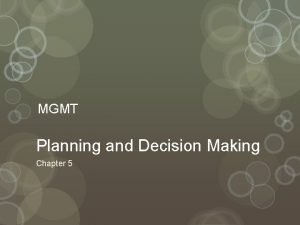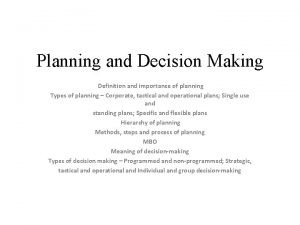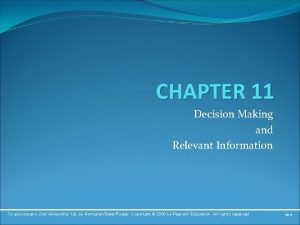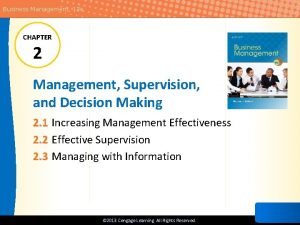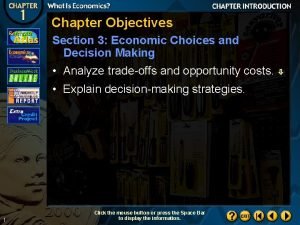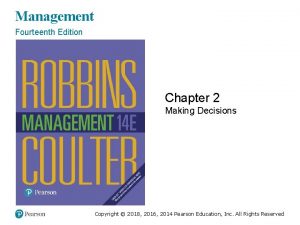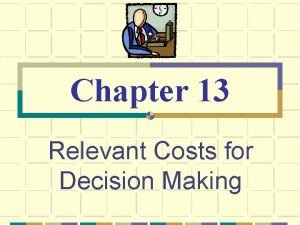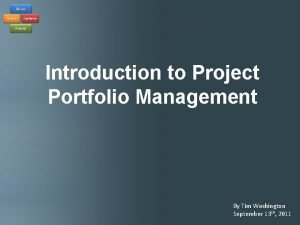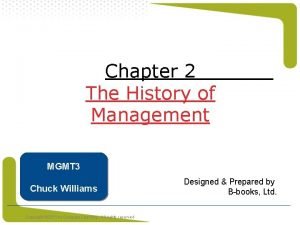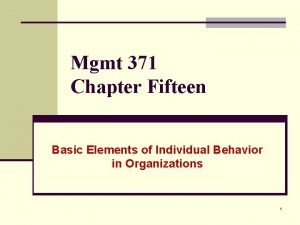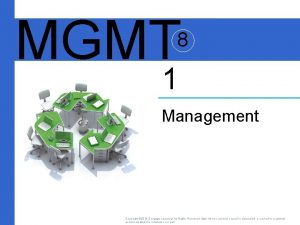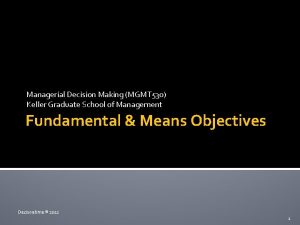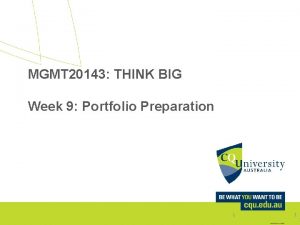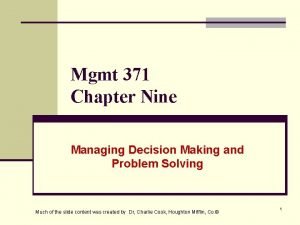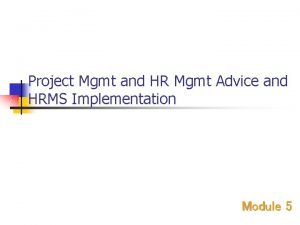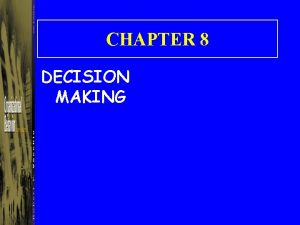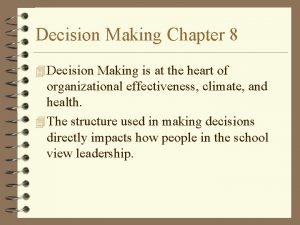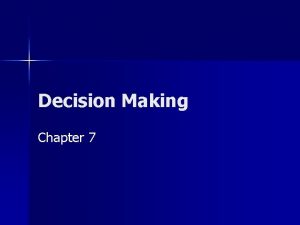MGMT Planning and Decision Making Chapter 5 Planning


























- Slides: 26

MGMT Planning and Decision Making Chapter 5

Planning Ø Choosing a goal Ø Developing a method or strategy to achieve that goal Ø Double-edged sword 2

Benefits and Pitfalls of Planning ØBenefits Ø Employee efforts intensified Ø Leads to persistence Ø Provides direction Ø Encourages the development of task strategies Ø Works for companies and individuals Ø Pitfalls Ø Impedes change Ø Prevents or slows needed adaptation Ø Creates a false sense of certainty – based on “assumptions” of what the future holds Ø Detachment of planners 3

How to Make a Plan That Works

Setting Goals Effective Planning S. M. A. R. T. Goals Ø Specific Ø Measurable Ø Attainable Ø Realistic Ø Timely 5

Effective Planning Developing Commitment to Goals Ø Goal commitment is the determination to achieve a goal Ø Techniques Ø Set goals collectively Ø Make the goal public Ø Obtain top management’s support 6

Effective Planning Develop Effective Action Plans An action plan lists… Ø Specific steps (how) Ø People (who) Ø Resources (what) Ø Time period (when) …for accomplishing a goal 7

Tracking Progress Effective Planning Ø Set proximal goals (short-term) and distal goals (long-term) Ø Gather and provide performance feedback Ø Needs to be regular and frequent to allow for adjustments 8

Effects of Goal Setting, Training, and Feedback on Safe Behavior in a Bread Factory

Maintaining Flexibility Effective Planning Ø Options-based planning Ø keep options open by making, small simultaneous investments in many alternative plans. Ø Slack resources Ø a cushion of resources, like extra time or money, that can be used to address and adapt to unanticipated changes. 10

Planning from Top to Bottom Ø Top management (long-term, conceptual) Ø Responsible for developing long term strategic plans Ø Strategic plans make clear how to serve customers and position against competitors for next 2 – 5 years Ø Purpose statement: Declaration of a company’s purpose or reason for existing (mission or vision) Ø Brief, clear, inspirational, consistent, and enduring Ø Strategic objective: Specific goal derived from the purpose statement Ø Unifies company-wide efforts Ø Stretches and challenges the organization Ø Possesses a finish line and a time frame 11

Planning from Top to Bottom Ø Middle management Ø Responsible for developing and carrying out tactical plans to accomplish strategic objective Ø Tactical plans: Specify how the company will use resources, budgets, and people to accomplish specific goals Ø Time frame – 6 months to 2 years Ø Management by objectives: 4 step process used my managers and employees Ø Discuss goals Ø Collectively select goals Ø Jointly develop tactical plans Ø Meet regularly to review progress toward goal accomplishment 12

Planning from Top to Bottom Ø First-level managers Ø Responsible for developing and carrying out operational plans – day-to-day plans Ø Time Frame – 30 days to 6 months Ø Operational plans Ø Single-use plans: Cover unique, one-time-only events Ø Standing plans: Used repeatedly to handle frequently recurring events Ø Policies – what to do if “x” happens Ø Procedures – more specific than polices Ø Rules & Regulations – even more specific than procedures Ø Budgeting: Managers decide how to allocate available money to best accomplish company goals 13

Steps to Rational Decision Making 1. Define the problem Ø Problem: Gap between a desired state and an existing state Ø Managers must: Ø Be aware of a problem Ø Be motivated to solve the problem Ø Have the knowledge, skills, abilities, and resources to fix the problem 2. Identify decision criteria Ø Decision criteria: Standards used to guide judgments and decisions 14

Steps to Rational Decision Making 3. Weigh the criteria Ø Absolute comparisons: Each decision criterion is compared to a standard or ranked on its own merits Ø Relative comparisons: Each decision criterion is compared directly with every other criterion 15

Absolute Weighting of Decision Criteria for a Car Purchase

Relative Comparison of Home Characteristics

Steps to Rational Decision Making 4. Generate alternative courses of action 5. Evaluate each alternative Ø Involves systematically evaluating each alternative against each criterion 6. Compute the optimal decision Ø Performed by multiplying the rating for each criterion by the weight for that criterion, and then summing the generated scores 18

Criteria Ratings Used to Determine the Best Location for a New Office

Limits to Rational Decision Making Ø Managers have to operate in a perfect world with no real-world constraints Ø Limited resources as well as attention, memory, and expertise problems make it difficult for managers to maximize decisions Ø Satisficing: Choosing a good-enough alternative 20

Advantage and Pitfalls of Group Decision Making Ø Advantages ØPitfalls Ø In the decision-making process groups perform better than individuals in: Ø Defining the problem Ø Generating alternative solutions Ø Groupthink: Barrier to good decision making Ø Intense pressure to agree with each other Ø Takes considerable time Ø Meeting complaints Ø Individuals can dominate group discussions Ø Equality Bias – individuals treat all group members as equally competent 21

Avoiding Pitfalls Using Groups to Improve Decision Making Ø Structured conflict - Right kind of conflict can lead to better group decision making Ø C-type (cognitive) conflict Ø Focuses on problem- and issue-related differences of opinion Ø Willingness to examine, compare, reconcile differences to produce the best possible solution Ø A-type (affective) conflict Ø Focuses on individuals or personal issues Ø Emotional reaction that can occur when disagreements become personal Ø Hostility, anger, resentment, distrust, cynicism, apathy 22

Creating C-Type Conflict Ø Devil’s advocacy Ø Dialectical Inquiry – propose solution (thesis), then generate an opposite proposal (antithesis) Ø Nominal Group Technique – Begins and ends by having group members write down and evaluate ideas Ø Shared with the group Ø Improves group decision making by decreasing a-type conflict Ø Delphi Technique Ø Don’t have to meet face-to-face Ø Members of a panel of experts respond to questions and to each other until reaching agreement on an issue Ø Brainstorming/Electronic brainstorming – all anonymous Ø Group members use computers to build on each others’ ideas Ø Generate as many alternative solutions as possible 23

Summary Ø Planning brings about increase in individual and organizational performance Ø Planning works best when the goals and action plans at the bottom and middle of the organization support the goals and action plans at the top of the organization Ø Decision making the process of choosing a solution from available alternatives 24

Key Terms Ø Ø Ø Planning S. M. A. R. T. goals Goal commitment Action plan Proximal goals Distal goals Options-based planning Slack resources Strategic plans Purpose statement Strategic objective Tactical plans Ø Ø Ø Management by objectives Operational plans Single-use plans Standing plans Policies Procedures Rules and regulations Budgeting Decision making Rational decision making Problem Decision criteria 25

Key terms Ø Absolute comparisons Ø Dialectical inquiry Ø Relative comparisons Ø Nominal group technique Ø Maximize Ø Delphi technique Ø Satisficing Ø Brainstorming Ø Groupthink Ø Electronic brainstorming Ø C-type conflict Ø Production blocking Ø A-type conflict Ø Evaluation apprehension Ø Devil’s advocacy 26
 Management chapter 5 planning and decision making
Management chapter 5 planning and decision making Management chapter 5 planning and decision making
Management chapter 5 planning and decision making Objectives of decision making
Objectives of decision making Dividend decision in financial management
Dividend decision in financial management What are the basic elements of planning
What are the basic elements of planning Individual and group decision making
Individual and group decision making Chapter 6 prices and decision making assessment answers
Chapter 6 prices and decision making assessment answers Five step decision making process
Five step decision making process Chapter 2 economic systems and decision making
Chapter 2 economic systems and decision making Chapter 2 economic systems and decision making
Chapter 2 economic systems and decision making Chapter 2 economic systems and decision making
Chapter 2 economic systems and decision making Chapter 11 decision making and relevant information
Chapter 11 decision making and relevant information Chapter 2 management supervision and decision making
Chapter 2 management supervision and decision making Relevant information for decision making
Relevant information for decision making Chapter 1 section 3 economic choices and decision making
Chapter 1 section 3 economic choices and decision making Financial decision making process
Financial decision making process Chapter 2 decision making
Chapter 2 decision making Relevant cost for decision making solution chapter 13
Relevant cost for decision making solution chapter 13 Infrastructure mgmt
Infrastructure mgmt Tim washington ppm
Tim washington ppm Chapter 2 history of management
Chapter 2 history of management Mgmt 4
Mgmt 4 Mgmt 371
Mgmt 371 Mgmt+8
Mgmt+8 Mgmt 371
Mgmt 371 Keller graduate school of mgmt
Keller graduate school of mgmt Mgmt 341
Mgmt 341

